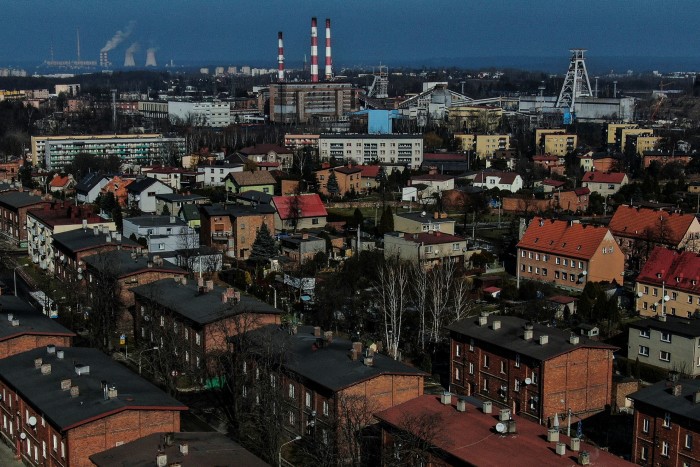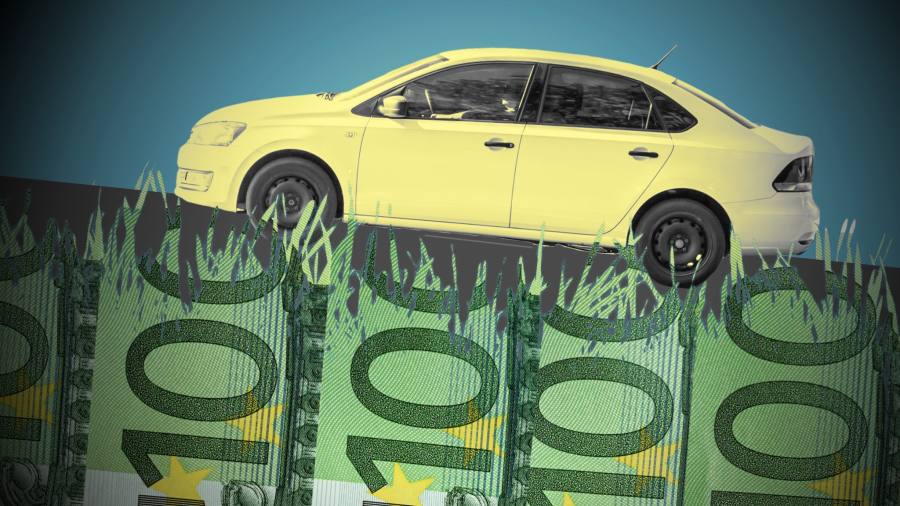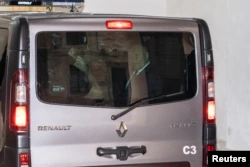[ad_1]
At the start of the year, the German government quietly launched a novel system of carbon pricing that could revolutionise who pays for the cost of polluting in Europe.
Since January, the EU’s largest economy has introduced a de facto tax of €25 per tonne of carbon on petrol, diesel, heating oil and gas to ramp up the cost of dirty energy and incentivise greener ways of living. It means millions of Germans will be paying more at the petrol pumps and in their heating bills.
Germany’s experiment, known as the National Emissions Trading Scheme, is enlisting consumers to help the country meet its aggressive emissions reduction targets.
The German carbon pricing model may soon go Europe-wide. Brussels is using it as a blueprint for its plans to extend the emissions trading scheme — its carbon pricing market — to swaths of the economy this summer as part of its goal of becoming the world’s first net zero emissions continent by 2050.
Climate scientists and economists largely agree that putting a prohibitively high price on CO2 — using a market-driven system or more crude carbon taxes — is an indispensable way to encourage consumers and companies into switching to greener ways of living.
Frans Timmermans, EU vice-commissioner for the Green Deal, has hailed Europe’s carbon pricing instrument as a “cornerstone” of the EU’s environmental agenda “because it’s been so successful”.
“It has put a price on carbon,” he says. “It is a huge incentivising instrument and it is clear that we need to expand it.”
But even before the new scheme is introduced, it is generating a storm of opposition. For a growing number of EU governments and some green activists, Brussels ambitions’ risk throwing Europe’s poorest inhabitants further into energy poverty by making them shoulder the burden of the bloc’s rush towards net zero.

They fear that without an accompanying system of mass state subsidies and financial compensation, carbon pricing will be a regressive tool that will punish millions of Europe’s poorest families who live in rented or social housing and are stuck with petrol-driven cars — ultimately serving to undermine public support for the EU’s ambitious climate goals.
Europe’s politicians are acutely aware of the French experience, when President Emmanuel Macron’s 2018 plan for petrol tax rises prompted the gilets jaunes protest movement.
The political blowback has been so fierce it is still not guaranteed that Brussels will go ahead with the plan.
“Right now the people directly impacted by Europe’s carbon price are a few thousand companies rather than millions of people,” says Pascal Canfin, a French MEP and head of the European parliament’s environment committee. He warns that Brussels will have to offer ways to alleviate the hit on consumers who face higher electricity bills, or risk “creating a major economic shock for the poorest households”.

Paying for the transition
At the crux of the EU’s drive to lower emissions is the future of Europe’s ETS, which covers sectors that account for around 40 per cent of the bloc’s emissions.
In July, the European Commission will propose expanding the ETS to consumer-facing sectors such as carmakers and buildings — a reform that would mirror the German model and mark a radical change in market-driven carbon pricing that is being watched by rich countries around the world.
The social consequences of expanding the ETS means the upcoming reform is already proving to be one of the most sensitive and contested parts of the EU’s radical decarbonisation agenda. Claude Turmes, Luxembourg’s environment minister, says his government will oppose any extension to cover cars and buildings because it “risks penalising lower income parts of the population”.

At a summit in Brussels in May, EU leaders from poorer eastern countries also warned that their citizens — many of whom cannot easily afford to ditch their diesel-powered cars or switch heating systems in rented accommodation — will suffer the ill-effects.
Europe’s governments have reasons to fear a societal backlash. France’s gilets jaunes exposed the fragile popular consensus that often underpins radical emissions targets — particularly if they are seen as disproportionately targeting lower- and middle-income households even in relatively richer economies.
“We have to do the [green transition] in such a way that all income levels can maintain their lifestyles,” Mark Rutte, Dutch prime minister said after the May summit in Brussels. “If we run up costs because of plans drawn up in Brussels or The Hague, we will lose support for what we are doing. It is crucial we carry society along.”

The debate over the future of the ETS strikes at the fundamental questions at the heart of Europe’s green agenda: who will pay for the transition and how?
Set up in 2005, Europe’s ETS created a cap-and-trade carbon market to incentivise major power companies and big industrial polluters to reduce their carbon footprint by forcing them to buy credits covering their emissions.
Companies who pollute more than their allocated share need to buy more credits, and less if they have falling emissions. In the last year, the cost of polluting determined by the ETS has skyrocketed by 60 per cent — hitting records of over €53 a tonne of carbon in the last month as investors bet on the EU coming good on its 2050 net zero target.
Brussels, which effectively controls the supply of credits by setting allocations for sectors and an overall emissions cap, estimates the price will have to hit upwards of €60 a tonne to meet the revised goal of a 55 per cent cut in CO2 emissions by 2030, based on 1990 levels.
Should the reform go ahead, it would transform the ETS from an esoteric market tool designed to place a prohibitively high price on dirty energy like coal, to a system that will set a de facto carbon price on companies accounting for nearly three-quarters of the EU’s emissions.

A senior EU official says the final decision on whether to press ahead with the expansion will be made at the “last minute” given the potential scale of opposition from member states. Brussels is planning to minimise the initial disruption from the ETS by setting up a smaller scheme covering just cars and buildings, commission president Ursula von der Leyen said this month. A crucial element will be the level at which the carbon price is set in the parallel system, with one official saying it is likely to be comfortably below the current ETS price.
Germany’s experience suggests that carmakers and building companies will pass on even modest CO2 costs to consumers. Germany’s €25 carbon price will increase the cost of a litre of diesel by €0.08, petrol by €0.07 and heating oil usage of 2,000 litres a year would be taxed €159, according to the Federation of German Consumer Organisations (VZBV).
On average, the system will mean a family of four with a petrol car and gas-fired heating would pay an additional €204 a year in 2021, rising to €451 in 2025 when the carbon price is forecast to rise to €55 a tonne.
Thomas Bobinger, EU policy officer at the VZBV, says the system is regressive as poorer households are often “trapped in fossil-fuel based activities and have to bear the carbon costs”. He adds: “Those with the lowest income don’t necessarily have the money to invest in energy efficiency. They can’t simply reduce their consumption by choosing not to drive their cars or turn on their washing machines. Tenants can’t switch their heating systems or insulate their walls.”
There have been few signs of a backlash in Germany, although Bobinger says it is too early to tell if the system is a success. “It has been five months since the pricing was introduced and people usually get their heating bills later in the year.”
Explicit costs
In Brussels, the cap-and-trade system has been seen as a more palatable alternative to imposing direct carbon taxes, which have been resisted by voters who fear it will drive up the cost of living.
The rising cost of carbon credits over the past year has also been seen as a vote of confidence in the ETS as investors have snapped up allowances, betting that their value will soar should the system expand to cover more sectors. Before 2020, the price of ETS credits rarely broke over €30 a tonne.
Other major economies are looking to follow Europe’s lead. Earlier this year China set up the world’s largest carbon market covering around 30 per cent of its total emissions. A handful of US states including California also have cap-and-trade schemes, while the post-Brexit UK in May launched its own ETS. The UK price has surged above the EU’s at more than £50 a tonne.
“We are reaching the point where the costs of decarbonisation cannot be hidden,” says Michael Pollitt, professor of business economics at Cambridge university. “The reason many are concerned about the ETS is that it makes this cost explicit — it is a direct price on polluting,” says Pollitt, who supports the expansion of the system as a way to “massively help increase the credibility of the net zero policy”.
The commission’s ETS reform will include a number of significant elements including gradually phasing out free allowances for sectors such as aviation that have been a feature of the system for decades. Brussels will also include shipping and maritime industries in the ETS for the first time — elements that are likely to help drive up the cost of polluting in the near term.

The ETS will play a central role in the EU’s multipronged strategy to dramatically drive down emissions. Brussels’ Green Deal philosophy combines using instruments such as the carbon market with harder legislative tools such as imposing binding standards on car emissions, higher renewable energy goals, and schemes to encourage private sector investment in green technologies.
A senior EU official describes the use of carbon pricing “as a minimum safety net” for taxing CO2 “but not a panacea” in the quest to decarbonise Europe’s economy.
Using ETS revenue
Environmental campaigners have warned against overextending carbon pricing and making the ETS carry the burden of hitting emissions targets. They fear the systemic changes needed to phase out fossil fuels, expand the availability of electric vehicles and decarbonise heavy industry can only be equitably achieved through regulation.
“The EU’s Green Deal can be an example to the world of how to do a swift and just transition, but only if it uses the right tools,” says Sofie Defour, climate manager at clean transport campaign group Transport & Environment. “The heavy lifting needs to come from things like emissions-free cars, rapid electrification and building up a world-class charging network.”

A study from Cambridge Econometrics estimates that extending carbon pricing to cars and homes would result in ETS allowances surging to €180 a tonne by 2030. The report’s modelling says the cost of gas heating for French households would nearly double over the next decade, and soar 188 per cent for coal-heated homes in Poland.
Under such a scenario, the report warns the hit to the EU’s economy can only be mitigated if all ETS revenues are recycled back to compensate vulnerable households and fund investment in cleaner technologies.
Yet Brussels has limited powers to force its governments to provide mass subsidies or tax breaks for citizens who have to pay the price. ETS revenues are shared out between the EU’s 27 governments who get the bulk of money from the system, with smaller funds designed to help lower-income member states fund renewable technology.
Europe’s member states are fiercely protective of the money they recoup and have already pushed back against Brussels’ plan to use a portion of the ETS proceeds to repay hundreds of billions in common EU debt issued to fund the Covid-19 recovery. “There are many customers for the ETS money and almost all of them will end up with less than they want,” says one EU official.
For Bobinger of Germany’s consumer federation, Europe’s move towards mass carbon pricing can’t happen without a serious conversation in Brussels and Europe’s capitals about how to offer direct compensation for households hardest hit.
“Welfare systems and social support mechanisms vary greatly in Europe. Unlike the US, the EU can’t hand out direct-stimulus cheques. It is unjust to say individuals can solve climate change by shifting their behaviour”, says Bobinger.
Cambridge university’s Pollitt warns that although the poorest in society can be shielded by state intervention, better off households will ultimately be forced to pay or change their habits.
“Achieving net zero in a 30-year timeline is a historic transition and politicians need to stop pretending that it can be done for free,” he says. “Governments can try and exempt the poorest from the whole costs, but the middle classes will have to pay for it.”
[ad_2]
Source link



